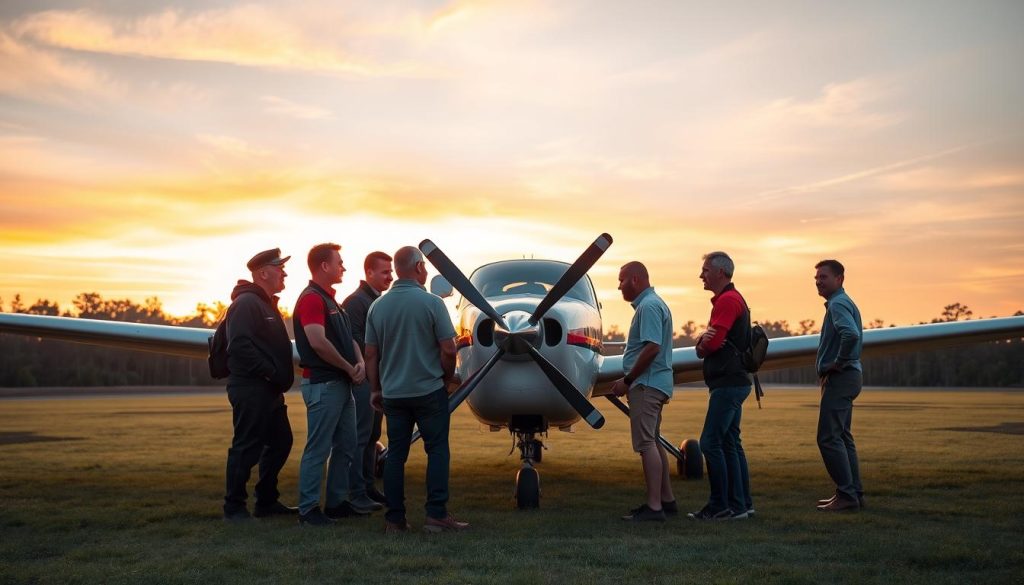For many aspiring pilots, becoming a flight instructor may be nothing more than a stepping stone, or a rung on the ladder of your aviation career. Perhaps you may see it as a way of “putting in the time”, to help you build up your hours, until you reach the magic number 1500, as required by the FAA.
But the reality is that flight instruction is more than that. It is a critical role in the world of aviation. As a flight instructor, you become one of the ambassadors of the aviation industry. One cannot get their pilot license without the instruction and endorsement of a Certified Flight Instructor (CFI).
Becoming a CFI is a unique undertaking in the sense that, through the process of mentoring others get their license, you are directly honing your own skills as a pilot. There’s a saying that you learn by teaching. With each student pilot you take under your wing (no pun intended), you’ll find yourself honing your own skills, becoming more proficient with respect to the FAA’s standards, with each lesson, and with each takeoff, and with each landing.
Becoming a CFI is an arduous path that demands pilots to develop a growth mindset. While it is indeed a stepping stone to help you build your hours, it is fundamentally an invaluable way to gain the experience that will open the doors for you in aviation. Likewise, it is a way of giving back to the aviation community, through your service as a means to help usher new pilots into the industry.
Key Takeaways
- Flight instructing builds vital experience for aspiring pilots.
- Meeting FAA requirements is crucial for career advancement.
- Flight instructors contribute significantly to aviation safety.
- Various certifications can enhance your teaching resume.
- Flight instruction offers flexibility in work hours.
- Flight instructors can earn competitive salaries based on experience.
Understanding the Role of a Flight Instructor
The role of a flight instructor is multifaceted, focusing on developing competent pilots. Flight instructing is more than just passing on knowledge. You are more than a teacher; you are a mentor shaping the future of aviation. Your tasks include teaching pilots the fundamentals of flight aerodynamics, aeronautical decision making, navigation, and aviation regulations. A deep understanding of these topics is crucial for students to progress in their training.
Practical experience is a key part of aviation training. As a flight instructor, you guide students through real-world flight maneuvers. You emphasize the need to master each skill before moving on. Your feedback is vital, helping students improve and meet standards while building their confidence.
Your responsibilities go beyond the classroom and cockpit. You must keep detailed records of student progress, flight hours, and training activities. This ensures compliance with FAA regulations and aids in planning each student’s learning path. Additionally, staying updated on industry changes through continuous professional development enhances your teaching quality.
In the aviation training environment, you embody professionalism and responsibility. You encourage students to strive for excellence while emphasizing the importance of safety and risk management. This balance is crucial in shaping the safest pilots possible.
Your influence on students and the aviation community is significant. The path from ground school to solo flight demands dedication from both you and your students. Your role is essential to their success.
Benefits of Flight Instruction in Career Development
Flight instruction is a unique pathway for those aiming to advance in the aviation industry. It not only helps you build crucial flight hours but also boosts your career through valuable experiences. As an instructor, you get to mentor students, enhancing their skills while refining your own.
One major benefit is the cost-effective way to gather flight hours, essential for airline jobs. Reaching the 1,500-hour milestone is key for commercial pilot roles. This milestone is a significant step in your career journey.
Airlines value candidates with flight instruction experience, seeing it as a sign of dedication and mentorship. The leadership and communication skills you develop are crucial in the competitive aviation job market. These abilities are vital for success in the industry.
Flight instructors are adept at analyzing complex situations and making timely decisions, traits airlines find attractive. The adaptability you gain from teaching diverse students prepares you for the dynamic nature of aviation operations.
The need for flight instructors is increasing, offering numerous job opportunities in educational settings. This role requires a significant investment of time and resources, showcasing your commitment to professionalism and excellence in aviation.
To delve deeper into the physical fitness standards required in order to become a pilot, refer to this resource. It underscores the critical role of health standards in the aviation sector.
How Flight Instructing Increases Your Flying Hours
Flight instructing is a key route for aspiring pilots to build their flying hours. It allows you to gain valuable experience while earning income. Each flight logged adds to your practical skills and meets aviation employer standards.
Importance of Logging Flight Hours
Accumulating flying hours is crucial for your pilot logbook. Each hour logged is a step towards meeting aviation career goals. Flight instructors get to experience different flight operations, improving their skills. This experience boosts your chances in aviation, whether as a commercial pilot or in specialized roles.
Meeting Airline Minimum Requirements
In order to become an airline pilot, you must first obtain an Airline Transport Pilot (ATP) rating. The Federal Aviation Regulations 14 CFR 61.159 outlines the requirements for earning the ATP.
Among the prerequisites for earning your ATP rating, is that you must have amassed a minimum total of 1,500 flying hours and that you must have a commercial rating.
Flight instructing is a very practical way to meet this requirement, and is, by far, one of the most popular paths to achieve this magic number. As a CFI, each hour that you provide flight instruction to a student, counts toward your own hours of flight time. All the while, this offers the benefit of reinforcing your own aeronautical knowledge and honing your own aeronautical skills.
Once you become a CFI, you can expand your qualifications to teach by adding on a CFII or MEI rating. This allows you to provide advanced flight instruction while also gaining hours on different aircraft types.
| Certification | Specialization | Potential Flight Hours |
|---|---|---|
| CFI | Basic Flight Instruction | Varies by the number of students and lessons |
| CFII | Instrument Flight Training | Increases owing to advanced training needs |
| MEI | Multi-Engine Training | Higher flying hours due to multi-engine flight instruction |
With a growing demand for commercial pilots, flight instructing is crucial. It not only builds flying hours but also lays a solid foundation for a successful aviation career.
What Is The Typical Roadmap For A CFI To Earn 1500 Hours?
The typical roadmap for a Certified Flight Instructor (CFI) to earn 1500 hours generally follows a structured path, beginning with obtaining essential pilot certifications. After earning a private pilot license (PPL), aspiring CFIs work through their instrument rating (IR), commercial pilot license (CPL), and finally their CFI certification, which typically requires about 250-300 flight hours. Once a CFI starts instructing, the average flight instructor logs between 60-100 hours per month, depending on factors like the type of flight school and local demand.
Flight instructing is one of the most common and reliable ways to accumulate flight hours. CFIs often instruct 5-10 students at a time, and over the course of 18-24 months, a busy CFI can reach 1500 hours, especially if they pursue additional ratings like CFII or MEI, which allow them to teach instrument or multi-engine flying, respectively. These additional qualifications can accelerate the hour-building process by providing more diverse teaching opportunities.
To learn more about the specific steps and strategies for building flight hours as a CFI, check out this this resource: What Is the Typical Roadmap for CFIs to Build 1500 Hours?
Enhancing Technical Skills through Flight Instruction
Engaging in flight instructor training is more than just teaching; it’s about sharpening your technical skills. Working with students at different flying levels pushes you to stay at the top of your game. This constant challenge helps refine crucial flying techniques.
Teaching students deepens your understanding of flight mechanics. You adapt your teaching to meet each student’s needs. This personalized approach boosts your flying skills and knowledge.
Being part of programs like WINGS helps you grow even more. The WINGS Program focuses on specific flight maneuvers for various aircraft. Regular training under this program ensures you meet safety standards and master proficient flying.
Staying active in such programs helps you grasp critical areas from accident analyses. By continually improving your technical skills through practice and structured lessons, you prepare yourself and your students for aviation success.
The Impact of Flight Instructing on Work-Life Balance
Exploring a career in aviation reveals a unique benefit in the flight instructing schedule for work-life balance. This schedule’s predictability stands in stark contrast to the irregular shifts and demanding travel schedules of traditional airline pilots.
Regular Work Hours
Flight instructing typically offers a consistent routine, allowing for regular working hours. This structured schedule aids in planning personal activities and ensures quality time with family and hobbies. The flying instructor advantage lies in this structured rhythm, promoting a healthier balance between work and personal life.
Less Travel Stress and Jet Lag
Flight instructors primarily operate in one time zone, avoiding the long-haul flights that cause jet lag and travel stress. This reduces overall health and well-being issues. The absence of constant travel allows for a stable connection to home life, reducing fatigue. This leads to a more fulfilling aviation career, as instructors focus on teaching without the stress of frequent time zone changes.

| Aspect | Flight Instructor | Airline Pilot |
|---|---|---|
| Work Hours | Regular and predictable | Irregular and varied |
| Travel Requirements | Limited, primarily local | Frequent, long-haul flights |
| Jet Lag | Minimal | Significant |
| Personal Time | More time available | Less time available |
Improving Soft Skills as a Flight Instructor
As a flight instructor, you are crucial in developing both technical and soft skills. These interpersonal abilities are key to your success in teaching pilots. They help build strong student relationships and ensure effective communication of complex information.
Effective Communication
Effective communication is essential in flight instruction. You must convey complex aviation concepts clearly. This ensures students fully grasp critical safety protocols. Employing strategies for different learning styles enhances understanding and retention.
This leads to safer and more competent pilots. It’s about both verbal and non-verbal communication skills.
Mentoring and Empathy
Teaching pilots requires a unique mentor-student relationship. Empathy is foundational, allowing you to adapt to each student’s needs and learning pace. This flexibility creates a supportive environment.
It encourages students to share their concerns and ask questions. Such an atmosphere fosters growth and reinforces learning experiences.
| Soft Skill | Importance | Application in Flight Instruction |
|---|---|---|
| Communication | Ensures complex ideas are understood. | Clear explanations of maneuvers and procedures. |
| Empathy | Nurtures student confidence and growth. | Adapting teaching styles to individual needs. |
| Mentoring | Guides students through challenges. | Providing feedback and support regularly. |
| Public Speaking | Builds confidence in instructional settings. | Instructing ground school classes and briefings. |
Flight Instructing as a Stepping Stone for Future Careers
Starting a career as a flight instructor is a smart move to gain valuable experience. It’s a stepping stone for those aiming for advanced roles in aviation. Many aspiring commercial pilots begin by becoming Certified Flight Instructors (CFIs). This path allows you to refine your flying skills and develop teaching techniques and interpersonal skills.
Flight instructing is a way to accumulate the flight hours needed by the FAA. It ensures you meet the minimum hours for more advanced positions. You’ll get to teach students, reinforcing your knowledge and helping others advance. This experience is key as you aim for a commercial pilot license or corporate pilot roles.
As a flight instructor, you prepare for various aviation opportunities. CFIs often move into airline, corporate, or FAA examiner roles. This shows the significant impact of flight instructing on both individual careers and the aviation community.
| Aviation Career Pathways | Required Flight Experience (Hours) | Typical Roles |
|---|---|---|
| Flight Instructor | Minimum 250 hours | Training upcoming pilots, enhancing your own skills |
| Commercial Pilot | Minimum 1,500 hours | Flying for airlines, charter services, etc. |
| Corporate Pilot | Minimum 1,200 hours | Operating private jets for corporations |
| FAA Examiner | Varies based on experience | Evaluating pilot proficiency |
This structured approach supports personal growth and highlights the role of mentorship in aviation. Each student you guide is a future pilot, contributing to a safer, more capable flying community.
Contributions to Aviation Safety
Flight instructing plays a crucial role in boosting aviation safety by fostering a strong safety culture among new pilots. Through detailed pilot training, instructors stress the need for a safety-first approach. This shapes future pilots who prioritize flying responsibly. Their dedication to safety ensures that essential skills for safe flying are developed early in their careers.
Instilling a Safety-First Mindset
During training, flight instructors emphasize key aviation safety principles. They foster an environment where students are encouraged to query and discuss safety measures. This approach shapes their decision-making and prepares them to handle cockpit challenges with confidence.
Shaping Responsible Future Pilots
Teaching the next generation of pilots requires more than just technical skills; it involves instilling responsible attitudes towards flying. Instructors who embody the aviation safety culture prepare students for real-world scenarios. They instill a sense of responsibility, ensuring these emerging pilots are not only technically skilled but also committed to maintaining the highest safety standards.
Building a Community in Aviation
Flight instructors are key in building a thriving aviation community. They engage deeply in the flight instructor network, connecting with peers, students, and enthusiasts. This collaboration boosts professional growth and shares a love for flying, forming a strong support network for personal and career advancement.
Networking in this field is abundant, with instructors sharing experiences and insights. These interactions inspire new teaching methods and perspectives. The importance of building relationships goes beyond friendship; it improves training quality and standards.
Professionalism and safety are paramount. Following the Flight Instructors Model Code of Conduct shapes teaching methods and strengthens the community’s integrity. By teaching responsible judgment and risk management, instructors help create skilled, ethical pilots who uphold these values in their careers.

The Experience of Teaching Future Pilots
Being a flight instructor is a unique chance to mold the careers of aspiring pilots. It comes with deep responsibilities and a fulfilling sense of purpose. You guide students through their aviation training, impacting their lives profoundly. Seeing students achieve flight training milestones, like their first solo, highlights your crucial role.
Mentoring the Next Generation
Your dedication to mentoring future pilots directly influences their growth and success. Engaging with students lays a solid foundation for their flight training. Many instructors stress the importance of a structured curriculum and lesson plans for effectiveness. Gary Reeves, the 2019 Flight Instructor of the Year, notes that consistency and a solid curriculum significantly enhance student achievements.
Celebrating Students’ Achievements
Your role goes beyond teaching; it’s about celebrating every student’s achievements. Each milestone reached shows your commitment and hard work. Recognizing these moments strengthens the instructor-student bond, improving the training experience. Instructors like Amy Hoover, who emphasizes frequent flying sessions, help students stay on track. Encouraging students to set goals and stay dedicated can greatly impact their aviation careers.
| Instructor | Specialization | Experience | Awards |
|---|---|---|---|
| Gary Reeves | General Aviation with GPS and Autopilot | 20 years | Flight Instructor of the Year 2019 |
| Amy Hoover | Tailwheel and Mountain Flying | 30+ years | Flight Instructor of the Year 2022 |
| Bob Raskey | Commercial Airline and Military | 23,000 hours | Flight Instructor of the Year 2023 |
Your passion for aviation and commitment to mentoring future pilots significantly impacts individual achievements and the aviation industry’s legacy. Embracing the educational impact you have on each student ensures a brighter future for aviation. As you continue in this rewarding profession, remember the importance of enthusiasm and dedication in shaping the next generation of pilots. Check out this resource for more information about maintaining aviation safety standards.
Keeping Current with FAA Regulations and Best Practices
As a flight instructor, it’s crucial to stay updated with the latest FAA regulations. These rules ensure your students receive training that meets industry standards. Engaging with aviation best practices is key for safe operations, especially during critical phases like takeoff and landing.
Knowing the current requirements, like those in FAR 61.57, is essential. For instance, pilots need to have done at least three takeoffs and landings in the last 90 days to be pilot-in-command. If flying at night, the same rule applies, focusing on landings between sunset and sunrise.
Instrument-rated pilots have specific duties, like logging six instrument approaches and holding procedures within six months. These updates highlight the need to meet standards for ongoing currency and safety in aviation.
The FAA Wings Program shows a structured way to keep training and development ongoing. It requires participation in safety seminars, online courses, and flight training to maintain sharp skills.
Regular flight instruction sessions are more than just a formality. They help instructors pinpoint areas for improvement in their students’ training. By focusing on the latest practices, both instructors and students gain a deeper understanding of aviation operations and safety.
Exploring Varied Opportunities in Flight Instruction
Flight instruction opens up a world of flying specialties, catering to diverse interests among aspiring pilots. You can specialize in various aviation disciplines, such as recreational, commercial, or instrument flying. This variety ensures a dynamic and engaging career, meeting the needs of students.
Teaching Different Types of Flying
As a flight instructor, you guide students through a range of flight licenses. This includes the Private Pilot License (PPL), Commercial Pilot License (CPL), and specialized ratings like Seaplane Rating or Light Sport Pilot License (LSA). Each license demands specific skills and knowledge, allowing for a personalized teaching approach. The practical experience from these roles boosts your professional growth and flying skills.
Specializing in Different Aviation Disciplines
Specializing in aviation disciplines can greatly enhance your instructor marketability. Focusing on areas like instrument flying or multi-engine operations attracts more students. Specialized training meets specific aviation sector demands, establishing you as an expert in your field. Explore opportunities for advancement and further certifications through resources like this comprehensive guide to flight licenses.
The Joy of Flying: The Heart of Flight Instruction
The joy of flying is at the core of flight instruction. As an instructor, you share your vast flight instruction experience and spark a passion for aviation in your students. Witnessing a student’s first solo flight is incredibly rewarding.
Instructors bring years of cockpit experience to the table. Doug Stewart, with over 13,500 hours of instruction, is a prime example. Each lesson is a chance to relive their love for flying while guiding the next generation. This creates a learning space filled with excitement and support.
Stories of aviation legends, like Lieutenant Colonel Herbert W. “Bill” Powley, show the power of teaching and passion for aviation. Powley has flown nearly 12,000 students on over 4,000 discovery flights.
Flight instruction is more than just technical skills and certifications. It’s the joy of flying that makes learning so enriching. Exploring resources on flight training, such as those made available through National Association of Flight Instructors (NAFI), can enhance your teaching and interactions with students.
Conclusion
Flight instructing is a foundational pillar of every professional pilot’s career in the aviation industry. It offers more than just a job; it enriches your professional life. It also plays a crucial role in the safety and growth of future pilots.
Through flight instruction, you gain invaluable experience and mentor aspiring aviators. This journey fosters personal growth and enhances your practical skills. It’s a rewarding experience that goes beyond the cockpit.
As a flight instructor, you contribute significantly to safety standards. You learn about risk management and aeronautical decision-making. Recent statistics show a decrease in fatal instructional accidents, highlighting safer training practices.
Your role is essential in adopting new techniques and technologies. This ensures the next generation follows these safety protocols. Your dedication to safety is crucial for the aviation industry’s future.
Flight instructing is more than just flying; it’s about shaping the industry’s future. By adhering to strict training standards and prioritizing safety, you help create a responsible aviation community. Your influence goes beyond the classroom, promoting a culture of excellence and safety.
FAQ
What qualifications do I need to become a flight instructor?
How does flight instructing help build my flying hours?
What are the benefits of becoming a flight instructor?
Can I specialize in a certain area of flight instruction?
What role do flight instructors play in aviation safety?
How does flight instructing affect work-life balance?
What makes flight instructors effective educators?
How can flight instructing advance my aviation career?
What influence do flight instructors have on their students?
How do I stay current with FAA regulations as a flight instructor?
Why is the relationship between instructors and students important?
Source Links
- https://asrs.arc.nasa.gov/publications/directline/dl7_instructor.htm
- https://atpflightschool.com/become-a-pilot/airline-career/flight-instructor-certificate.html
- https://www.faasafety.gov/files/gslac/library/documents/2007/Sep/19529/Introduction to Scenario-Based Training.pdf
- https://www.cfinotebook.net/lesson-plans/fundamentals-of-instructing/flight-instructor-techniques.php
- https://www.flightschoolusa.com/flight-instructor-duties-ultimate-guide-to/
- https://calaero.edu/become-a-pilot/flight-instructors/what-does-a-flight-instructor-do/
- https://aerocadet.com/blog/why-you-should-become-a-flight-instructor/
- https://www.flightschoolusa.com/flight-instructor-know-the-5-ultimate-bene/
- https://www.flyaeroguard.com/blog/top-10-benefits-of-becoming-a-flight-instructor/
- https://www.safetyinmotion.aero/flight-instructing
- https://leopardaviation.com/1500-hour-rule/
- https://www.faasafety.gov/wings/pub/learn_more.aspx
- https://www.cfinotebook.net/lesson-plans/fundamentals-of-instructing/instructor-responsibilities-and-professionalism.php
- https://rodmachado.com/blogs/learning-to-fly/79485318-bad-instructors-how-they-behave-and-why-you-should-know?srsltid=AfmBOoqi8W_OUR60ltDxo216QLXu6mXMvoAkeYZtZ_qc4Jp6i7IqJY8o
- https://commons.erau.edu/cgi/viewcontent.cgi?article=1365&context=ijaaa
- https://www.faa.gov/sites/faa.gov/files/2022-10/AC60-22part2.pdf
- https://www.cfiacademy.com/essential-skills-every-certified-flight-instructor-should-master/
- https://nbaa.org/news/business-aviation-insider/202407/soft-skills-are-key-in-crew-resource-management/
- https://tfaflights.com/index.php/programs/flight-instructor-cfi
- https://www.av8prep.com/aviation-library/pilot-training/the-expedition-to-becoming-a-certified-flight-instructor-cfi
- https://www.flightschoolusa.com/flight-instructor-certificate-ultimate-gui/
- https://www.nafinet.org/awards
- https://www.nafinet.org/flight-instructor-hall-of-fame
- https://www.secureav.com/FIMCC-v1.0.htm
- https://medium.com/faa/inflight-insights-e358f87ed026
- https://www.flyingmag.com/what-a-cfi-wants-you-to-know/improving-cfi-training-remains-a-never-ending-goal/
- https://medium.com/faa/heres-my-advice-9e42ce94715d
- https://www.flyingmag.com/strategy-staying-current/
- https://www.av8prep.com/aviation-library/pilot-training/maintaining-efficiency-and-staying-current-as-a-licensed-pilot
- https://www.faasafety.gov/gslac/ALC/course_content_popup.aspx?cID=472&sID=769&preview=true
- https://www.av8prep.com/aviation-library/pilot-training/exploring-various-types-of-flight-licenses
- https://aviex.goflexair.com/blog/guide-to-flight-training
- https://airfactsjournal.com/2019/05/lessons-from-a-later-bloomer-cfi-and-why-you-should-be-one-too/
- https://www.nafinet.org/cfi-hof-inductees
- https://aopa.org/training-and-safety/air-safety-institute/accident-analysis/flight-training-accident-report/conclusions-and-recommendations
- https://www.cfiacademy.com/the-significance-of-safety-in-flight-instruction-best-practices-for-instructors/




